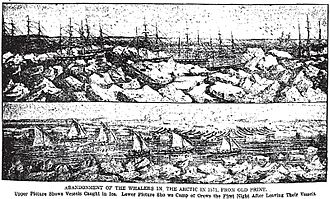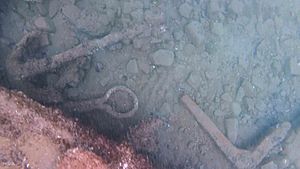Whaling Disaster of 1871 facts for kids
The Whaling Disaster of 1871 was an incident off the northern Alaskan coast in which a fleet of 33 American whaling ships were trapped in the Arctic ice in late 1871 and subsequently abandoned. It dealt a serious blow to the American whaling industry, already in decline.
The 1871 whaling season
In late June 1871, forty whaleships passed north through Bering Strait, hunting bowhead whales. By August the vessels had passed as far as Point Belcher, near Wainwright, Alaska, before a stationary high, parked over northeast Siberia, reversed the normal wind pattern and pushed the pack ice toward the Alaskan coast. Seven ships were able to escape to the south, but 33 others were trapped. Within two weeks the pack had tightened around the vessels, crushing three ships - Comet on September 2, Roman on September 7, and Awashonks on September 8. The crews were divided among the rest of the vessels.
The remaining vessels were spread out in a long line, some 60 miles (97 km) south of Point Franklin. On September 12 the masters met aboard Champion and agreed that, weather permitting, they would evacuate within the next few days. Each master was to return to their ship and prepare whaleboats lightened of gear so that they could be slid across the ice between the open-water. The ships were strung-out over some 50 miles at this time, in open water in groups of three to five, separated by ice, but within sight of other ships. The signal of abandonment was to strike the American flag. On the morning of September 14 scout boats from the John Wells and Eugenia returned with the news of the rescue ships waiting to the south . After each the ships struck their flag, the 1,219 people aboard the ships evacuated in small whaleboats with a three-month supply of provisions, crossed 70 miles (110 km) of ocean and ice, and were eventually brought to safety by the seven ships which had escaped the ice to the south. Amazingly, there were no casualties. It was widely reported and accepted that a single crew member stayed on the Massachusetts through that winter, but his identify has been lost to history.
The seven whalers that escaped took the following number of rescued whale men: the Europa (280), the Arctic (250), the Progress (221), the Lagoda (195), the Daniel Webster (113), the Midas (100), and the Chance (60). They were forced to dump their catch and most of their equipment overboard to make room for passengers on the return trip to Honolulu. The last of the rescue ships, the Chance, arrived on November 22.
The total loss was valued at over $1,600,000 ($39.08 million in today's dollars). Twenty-two of the wrecked vessels were from New Bedford, Massachusetts. In 1872 the bark Minerva was discovered intact and subsequently salvaged, but the rest were crushed in the ice, sank, or were stripped of wood by the local Inupiat. It is reported that the Concordia, George Howland, and the Thomas Dickason, owned by George (Jr.) and Matthew Howland brothers, were not insured and represented 1/3 of their fleet.
Lost whaling vessels
The lost vessels were as follows:
| Vessel | Homeport | Captain | Est Vessel value | Notes |
|---|---|---|---|---|
| Awashonks | New Bedford, MA | Ariel Norton | $58,000 | Crushed in the ice on September 8, 1871. |
| Concordia | New Bedford, MA | Robert Jones | $75,000 | Abandoned and lost. Wreck burned by Inuit. This ship was on its maiden voyage |
| Contest | New Bedford, MA | Leander C. Owen | $40,000 | Abandoned and lost. |
| Elizabeth Swift | New Bedford, MA | George W. Bliven | $60,000 | Abandoned and lost. |
| Emily Morgan | New Bedford, MA | Benjamin Dexter | $60,000 | Abandoned and lost. Wreck later found ashore. |
| Eugenia | New Bedford, MA | Daniel B. Nye | $56,000 | Abandoned and lost. |
| Fanny | New Bedford, MA | Lewis W. Williams | $58,000 | Abandoned and lost. |
| Gay Head | New Bedford, MA | William H. Kelley | $40,000 | Abandoned and lost. Wreck burned by Inuit. |
| George | New Bedford, MA | Abraham Osborn | $40,000 | Abandoned and lost. |
| George Howland | New Bedford, MA | James H. Knowles | $43,000 | Abandoned and lost. |
| Henry Taber | New Bedford, MA | Timothy C. Packard | $52,000 | Abandoned and lost. |
| John Wells | New Bedford, MA | Aaron Dean | $40,000 | Abandoned and lost. |
| Massachusetts | New Bedford, MA | West Mitchell | $46,000 | Abandoned and wrecked. A lone sailor remained with the wreck through the winter. |
| Minerva | New Bedford, MA | Hezekiah Allen | $50,000 | Abandoned. Discovered intact in 1872; manned and taken south. |
| Navy | New Bedford, MA | George F. Bouldry | $48,000 | Abandoned and lost. |
| Oliver Crocker | New Bedford, MA | James H. Fisher | $48,000 | Abandoned and lost. |
| Reindeer | New Bedford, MA | B. F. Loveland | $40,000 | Abandoned and lost. Sunken wreck found in 1872. |
| Roman | New Bedford, MA | Jared Jernegan | $60,000 | Crushed in the ice on September 7, 1871. |
| Seneca | New Bedford, MA | Edmund Kelley | $70,000 | Abandoned and lost. Beached wreck found in 1872. |
| Thomas Dickason | New Bedford, MA | Valentine Lewis | $50,000 | Abandoned and lost. Wreck found in 1872. |
| William Rotch | Honolulu, HI | Benjamin D. Whitney | $43,000 | Abandoned and lost. |
| Monticello | New London, CT | Thomas W. Williams | $45,000 | Abandoned and lost. |
| J.D. Thompson | New London, CT | Capt. Allen | $45,000 | Abandoned and lost. |
| Carlotta | San Francisco, CA | E. Everett Smith | $52,000 | Abandoned and lost. |
| Florida | San Francisco, CA | D. R. Fraser | $51,000 | Abandoned and lost. Wreck burned by Inuit. |
| Victoria | San Francisco, CA | Capt. Redfield | $30,000 | Abandoned and lost. |
| Comet | Honolulu, HI | "Capt. Sylvia" (possibly Joseph D Silva) | $20,000 | Crushed in the ice on September 2, 1871. |
| Julian | Honolulu, HI | John Heppingstone | $40,000 | Abandoned and lost. |
| Kohola | Honolulu, HI | Alexander Almy | $20,000 | Abandoned and lost. Wreck later found ashore. |
| Paiea | Honolulu, HI | Capt. Newbury | $20,000 | Abandoned and lost. |
| Champion | Edgartown, MA | Henry Pease | $40,000 | Abandoned and lost. Wreck later found ashore. |
| Mary | Edgartown, MA | Edward P. Herendeen | $57,000 | Abandoned and lost. |
Two of the wrecks located (2015)
In 2015, NOAA funded a research expedition entitled "The Search for the Lost Whaling Fleets of the Western Arctic". 144 years after the disaster, acoustic mapping of the ocean floor detected the wrecks of two whaleships that were "remarkably well preserved". Visualized details of anchors, fasteners, ballast, and the brick-lined try-pots positively identified them as 19th century whalers. Although many whaleships hunted in those waters, the expedition archeologist and co-director Dr. Brad Barr believes that they are wrecks from the 1871 disaster, as it is the same area where whaleship planks washed up on shore for many years after 1871. The identity of the two wrecks is currently not known. Due to the shallow depths of the survey area (average depth was 28 feet), it is thought by the expedition leaders that the other wrecks were destroyed over time by the action of the sea. The site is protected under Historic Protection Laws of the United States, and NOAA has not released the precise location to the general public. Dr. Barr was hopeful that expeditions by other marine archeologists could do a more complete survey of the wrecks some time in the future, possibly even identifying them, but NOAA will likely not return to the area again.





